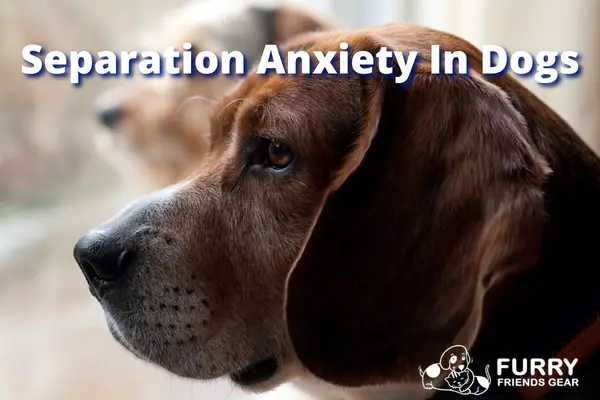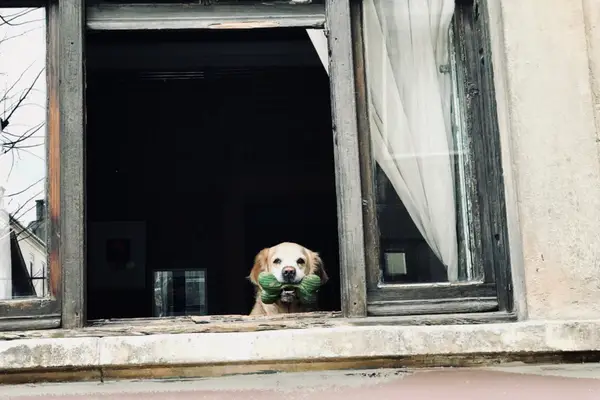
Your dog is whining or crying as you prepare to leave; an overly excited dog greeting you with a messy home right behind him; scratches on the floor and some bite marks on the windowsill, too; your dog won’t stop following you from one room to another; finally, you get a call from your neighbor complaining about how your dog is barking non-stop while you’re away. Do you find yourself asking, “How do you stop separation anxiety in dogs?”
Well, you’re not alone. If you are familiar with at least one or all of these scenarios, then your dog might be experiencing separation anxiety. If you’re not familiar with this, it’s when your dog starts showing signs of stress every time you leave.
Separation anxiety can range from mild to severe, and it’s definitely something that you shouldn’t take lightly. If not attended to, your dog might never be able to cope with it, and it can cause a lot of stress for you and your neighbors, too.
Fortunately, there are lots of ways that you can help your dog cope with separation anxiety, and this is exactly what we’re going to share with you below.
Separation Anxiety In Dogs: Tips For Stopping It
As dog owners, it’s important to help your dog cope with separation anxiety. This is definitely something that isn’t easy to treat. It will require lots of your time, patience, and effort.
Below, we enumerate some tips on how you can handle separation anxiety in dogs. As these tips will help your dog better cope with his anxiety, it also helps in preventing young puppies from acquiring this:
1) Build Your Dog’s Tolerance for Alone Time
One way to reduce separation anxiety in dogs is by building up your dog’s tolerance for alone time. This way, he learns to be independent and not get stressed out every time he’s left alone. You need to teach your dog not to come near you all the time.
Here’s how you can do this:
- Take your dog to a room and spend some time with him. It’s alright even if it’s not long.
- Pet your dog while in the room and speak to him softly before leaving him.
- Leave the room and close the door behind you so your dog won’t follow you.
- After that, wait and observe what your dog will do.
If this is the first time you’re doing this, there’s a big possibility your dog will really cry. He might even get wild. If this happens, just let him. Remove any items inside the room that might get broken if your dog runs wild inside.
If you don’t want to feel bad, you can leave some toys or treats for your dog inside, too. This will help keep them entertained while you’re away. Separation anxiety in dogs can be alleviated through consistent affirmation.
It’s recommended to do this only once a day so as not to increase your dog’s stress. The time you leave should also be gradually increasing every day until your dog gets used to it.
2) Don’t Let Your Dog Follow You Around When At Home
Another way that separation anxiety in dogs is displayed is when your dog follows you around the house. This is because he’s scared that you’ll be gone again. Though this looks very cute, a clingy attitude isn’t something that you should tolerate.
There are three methods that you can do to stop your dog from following you wherever you go:
Creating a Routine: The first thing you can do is create a new routine for your dog. For example, you can extend playtime or exercise time so your dog can expel all the excess energy. If this happens, he’ll spend a lot of time napping instead of following you around the rest of the day.
You can also buy some food puzzle toys for your dog so you can spread some treats around the house for your dog to find. It will keep him entertained throughout the day. On top of that, he’ll know that he doesn’t need you to be there for him to find something to eat.
Another thing some dog owners do is set a specific time schedule for when they’ll give their dog attention. You can schedule about an hour or two hours of playtime during the day and another at night. Then, hours after that, leave him alone.
If you love cuddling with your dog, stop doing that, too. Get him a bed of his own. You can also utilize baby gates to prevent your dog from entering rooms where you usually enjoy some me-time.
Teach your dog to “stay”: Another method used by other dog owners is teaching their dog to “stay” whenever he’s following you.
Every time he follows you, the trick is to stop, turn around, and tell them to stay. Make sure you’re firm here as you don’t want this to appear like playtime. You can also use your hand as a signal while you’re saying the command.
When your dog stays put, don’t forget to reward him. It’s good if you have some treats in your pocket ready, but if you don’t, some verbal praise will do.
Do this a couple of times a day, every day, until your dog finally gets that you’re doing this because you need some space from him. Eventually, he’ll find something fun to do himself.
Give him his own space: One of the reasons your dog follows you around is because he thinks that the whole house is his territory. However, if you make it clear where he’s allowed and where he’s not, he might end up not following you in the no-dog zone areas.
Regardless of which method you follow, make sure you do this consistently. You should also be very patient as this might take weeks to months before you get rid of the clinginess in your pet.

3) Change Your Going Away Signals
The next thing you can do to stop separation anxiety in dogs is to change your going away signals. These are the common things you do before you leave.
Dogs are very observant, especially when it comes to their humans. They know even the tiniest detail about you, and that includes your going away signals. You may not notice that you have a routine, but your dog surely does. And once they see this, they already start panicking.
Separation anxiety in dogs increases because they learn your exit behaviors. To decrease your dog’s stress because you’re leaving, don’t leave any hints.
For example, if you tend to wear your coat, say goodbye, then walk out the door, it’s already printed in your dog’s mind that you’re leaving every time you do that. So, next time, try to wear your coat but don’t leave yet. This will get your dog thinking that maybe you wearing a coat isn’t a signal that you’re leaving after all.
You can also try leaving your purse and keys in different locations every day, so your dog doesn’t get familiar with them. If you tend to go out through the main door, try the back door once. You can even do these going away signals even if you’re not leaving. You can grab your car keys but sit on a sofa after.
Doing even the slightest change in your routine before you leave will help lessen your dog’s stress. It also helps him disassociate those actions as signals. So that the next time he sees you grabbing those keys, it’s either you’re leaving, or you’re not, instead of just being sure that you’re really going.
4) Be Calm When Arriving or Leaving Your Dog
Another crucial part of reducing separation anxiety in dogs is being calm before leaving your dog, and once you get back home. Because as we all know, we dog owners tend to be overly dramatic when saying our goodbyes and hellos. It’s like our way of showing them how much we love them.
However, we may not be aware that these greetings will stir up some negative emotions inside them. It will let them feel more afraid of being alone. This is because they think you are nervous about leaving them, too, making them anxious.
This is the same thing as when you arrive and excitedly greet them. Yes, it tells them you’ve missed them so much, but it’s also not helping him recover from the anxiety.
So, instead of being too overly emotional, stay calm about everything. Don’t make a big deal about saying goodbyes. You can distract him for a while and just leave. Don’t greet an overly excited dog immediately, too; instead, wait until your dog stays put before petting him and giving him a treat.
5) Take Your Dog Out For An Exercise
Like they always say, a tired dog is a behaved and calm dog. Separation anxiety in dogs can be severely reduced with proper exercise.
You can take your dog out for a walk or exercise until he’ll be able to expel all his energy. This way, by the time he gets back home, his priority is eating or sleeping. So, by the time you leave, he’s already distracted and might not even notice you leaving.
Aside from the fact that this calms him down and helps your dog cope with separation anxiety, exercise, in general, offers lots of benefits for your dog.
Related article: How Do You Help A Dog With Separation Anxiety At Night?
6) Feed Your Dog Before Leaving
Aside from exercise, you shouldn’t forget to feed your dog before leaving. This makes him content and relaxed, which might even make him take a nap. Separation anxiety in dogs may be reduced if they get fed.
On top of feeding him, don’t forget to leave some treats for him, too. You can buy some treat dispensing toys that can feed your dog and entertain him, too. You can also leave treats all around the house to give your dog something to look forward to every time he’s alone.

7) Leave Some Toys
A great way to reduce separation anxiety in dogs is by leaving some toys for your dog. If your dog loves some particular toys, make sure to leave them in an area where he can find them easily. These toys are what will keep him company while you’re not home.
There are also some specific behavioral toys available in the market that you can buy for your dog. Each toy will help solve a specific problem, so it’s probably best to really do some research first on what kind of toy to get.
8) Hire a Dog Walker
Dog walkers help to limit separation anxiety in dogs. This is most especially important if you’re going out for a few days trip. You can get your neighbor, a family member, or a friend.
Just remember that when hiring a dog walker, you should hire someone that you and your dog can trust. Because it really won’t ease your dog’s anxiety if you leave him with someone he’s not comfortable with.
9) Seek Professional Help
If all else fails when stopping separation anxiety in dogs, seek professional help. Regardless if you think your dog has a mild or severe case of separation anxiety, taking him to the vet is always necessary.
Separation anxiety in dogs is not simple, and it’s not very easy to treat. Triggers and symptoms vary from one dog to another, so what your dog needs may vary, too. Other than that, there’s also this possibility that your dog doesn’t even have one.
With the help of a professional, you’ll be able to determine what’s wrong and what kind of treatment is needed. They can even prescribe your dog some medicine or calming aids to help your dog cope with the anxiety easier.
Conclusion
Separation anxiety in dogs should never be taken lightly. As dog owners, it’s your goal to ensure that your dog’s anxiety level doesn’t reach a dangerous state. Pay attention to what your dog needs.
If you’re a dog owner who's just adopted a dog that’s been left alone before, the trauma is already there. So make sure to shower them with lots of love and show them that no matter what happens, you’re not going to leave him for real.
https://www.furryfriendsgear.com/separation-anxiety-in-dogs/?feed_id=311&_unique_id=63176c517aa4f
No comments:
Post a Comment